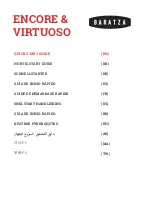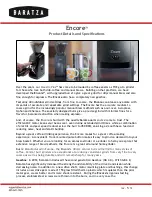
2
g.
Use the power tool, accessories and tool bits
etc., in accordance with these instructions and
in the manner intended for the particular type
of power tool, taking into account the working
conditions and the work to be performed.
Use
of the power tool for operations different from
intended could result in a hazardous situation.
5. SERVICE
a.
Have your power tool serviced by a qualified
repair person using only identical replacement
parts.
This will ensure that the safety of the power
tool is maintained.
SPECIAL SAFETY RULES
WARNING
The product is not intended for use by persons
(including children) with reduced physical, sensory
or mental capabilities, or lack of experience
and knowledge, unless they have been given
supervision or instruction concerning use of the
product by a person responsible for their safety.
Children should be supervised to ensure that they
do not play with the product.
■
This appliance is not intended for use by young
children or infirm persons.
Adequate supervision by
a responsible person must be provided to ensure that
they do not play with the appliance.
■
Keep children and visitors away.
Visitors should
wear safety glasses and be kept a safe distance from
work area. Do not let visitors contact tool or extension
cord.
■
Complies with AS/NZS 60745.
■
It is recommended that this tool always be supplied via
a residual current device with a rated residual current
of 30mA or less.
SAFETY INSTRUCTIONS FOR ALL OPERATIONS
SAFETY WARNINGS COMMON FOR GRINDING
OPERATIONS:
a.
This power tool is intended to function as
a grinder tool. Read all safety warnings,
instructions, illustrations and specifications
provided with this power tool.
Failure to follow
all instructions listed below may result in electric
shock,
fi
re and/or serious injury.
b.
Operations for which the power tool was not
designed may create a hazard and cause
personal injury.
c.
Do not use accessories which are not
specifically designed and recommended by the
tool manufacturer.
Just because the accessory
can be attached to your power tool, it does not
assure safe operation.
d.
The rated speed of the accessory must be at
least equal to the maximum speed marked on
the power tool.
Accessories running faster than
their rated speed can break and
fl
y apart.
e.
The outside diameter and the thickness of your
accessory must be within the capacity rating
of your power tool.
Incorrectly sized accessories
cannot be adequately guarded or controlled.
f.
The arbour size of wheels, flanges, backing
pads or any other accessory must properly
fit the spindle of the power tool.
Accessories
with arbour holes that do not match the mounting
hardware of the power tool will run out of balance,
vibrate excessively and may cause loss of control.
g.
Do not use a damaged accessory. Before each
use inspect the accessory such as abrasive
wheels for chips and cracks, backing pad
for cracks, tear or excess wear, wire brush
for loose or cracked wires. If power tool or
accessory is dropped, inspect for damage
or install an undamaged accessory. After
inspecting and installing an accessory,
position yourself and bystanders away from
the plane of the rotating accessory and run the
power tool at maximum no-load speed for one
minute.
Damaged accessories will normally break
apart during this test time.
h.
Wear personal protective equipment.
Depending on application, use face
shield, safety goggles or safety glasses.
As appropriate, wear dust mask, hearing
protectors, gloves and workshop apron
capable of stopping small abrasive or
workpiece fragments.
The eye protection must
be capable of stopping
fl
ying debris generated by
various operations. The dust mask or respirator
must be capable of
fi
ltrating particles generated
by your operation. Prolonged exposure to high
intensity noise may cause hearing loss.
i.
Keep bystanders a safe distance away from
work area. Anyone entering the work area
must wear personal protective equipment.
Fragments of workpiece or of a broken accessory
may
fl
y away and cause injury beyond immediate
area of operation.
j.
Hold power tool by insulated gripping surfaces
only, when performing an operation where the
cutting accessory may contact hidden wiring
or its own cord.
Cutting accessory contacting a
“live” wire may make exposed metal parts of the
power tool “live” and shock the operator.
k.
Position the cord clear of the spinning
accessory.
If you lose control, the cord may be cut
or snagged and your hand or arm may be pulled
into the spinning accessory.
l.
Never lay the power tool down until the




























